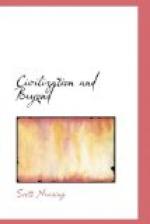Any student of the sociology of civilization must turn from this analysis of function with the conviction that whatever the advantages of civilization as opposed to earlier phases of human association, the pattern of civilization in action is workable only to a very limited extent. Civilization is not an example of perpetual motion. Rather it is a social life cycle, with a beginning and an end, and a peck of troublesome contradictions and conflicts in between.
Civilization is an integrative process. During the course of its competitive survival struggle, potential building units of an expanding civilization are tested out and included or rejected in much the same way that a stone-mason checks and tests the individual stones of which his wall is being built. The analogy is not entirely accurate. A wall becomes a completed part of a total structure. A civilization is a process of existence from conception and birth to dissolution and death. At any point in the process there is a delicate balance between integration and disintegration. As a matter of fact, both integration and disintegration exist and act, constantly, side by side. If the integrative forces are in the ascendant, form is built and function is accelerated. If the disintegrative forces are dominant, form breaks down and function stagnates.
This shifting balance and/or imbalance with its resulting build-up and/or break-down exists geographically, biologically, sociologically. It can perhaps be best described as successive change. It cannot be referred to as evolution except in its integrative aspect. Disintegratively it becomes devolution.
Civilization is a result of sociological build-up at a certain cultural level. It has not been universal in all human societies, but exceptional, both in time and in geographical space.
What has caused the pattern of civilization to appear, disappear and reappear again and again during the period of written history?
There have been many answers. The most general answer is divine intervention by beings above and beyond mankind. Whether such intervention has taken place or is taking place, human beings are unable to say with finality, but several thousand years of recorded history, plus our own daily experience provides convincing proof that the political, economic, ideological and sociological constructs which have appeared and disappeared in the course of social history are, at least in large part, the products of human brains and human hands. They are man-made.
The social pattern of civilization, like other social patterns which preceded civilization and which continue to exist side by side with civilized communities, is the result of human ingenuity and human energy, of human inertia, ineptitude, and the human urges to build, decorate and destroy.
Variety in human culture is caused by the variety in the human natural environment, the human social environment and in man himself.




